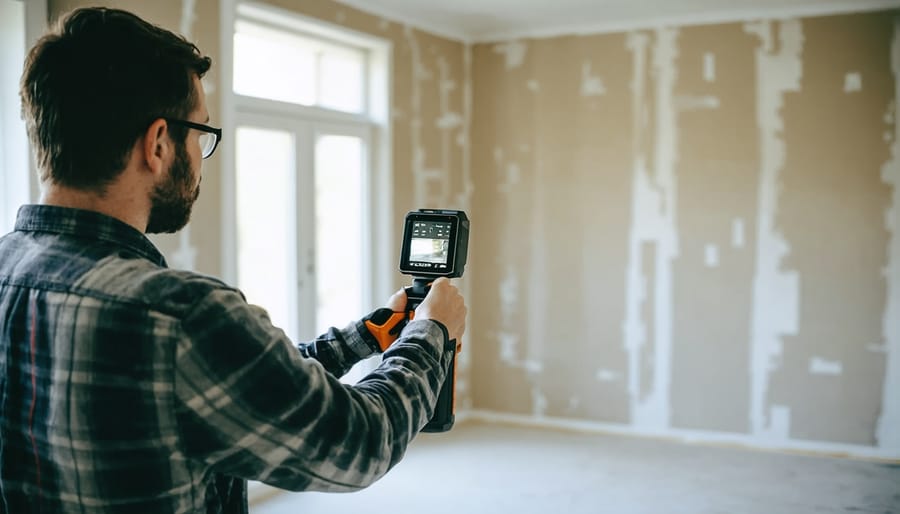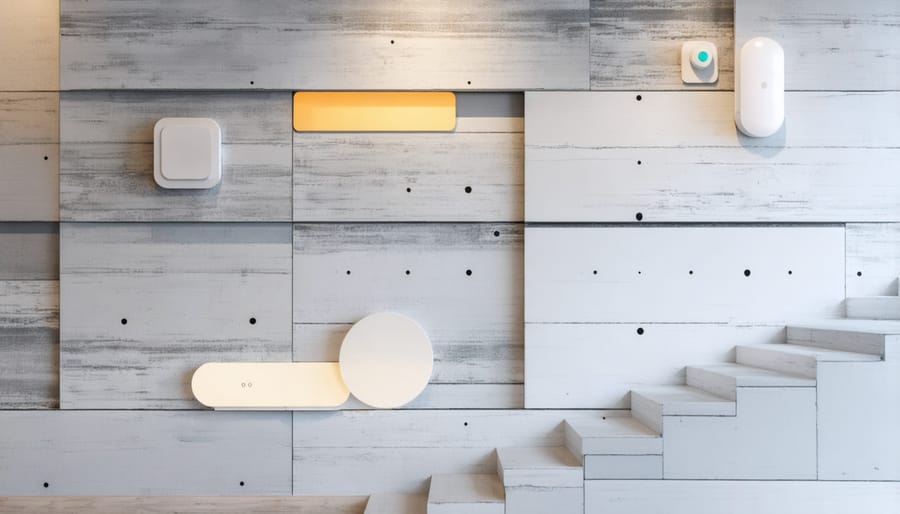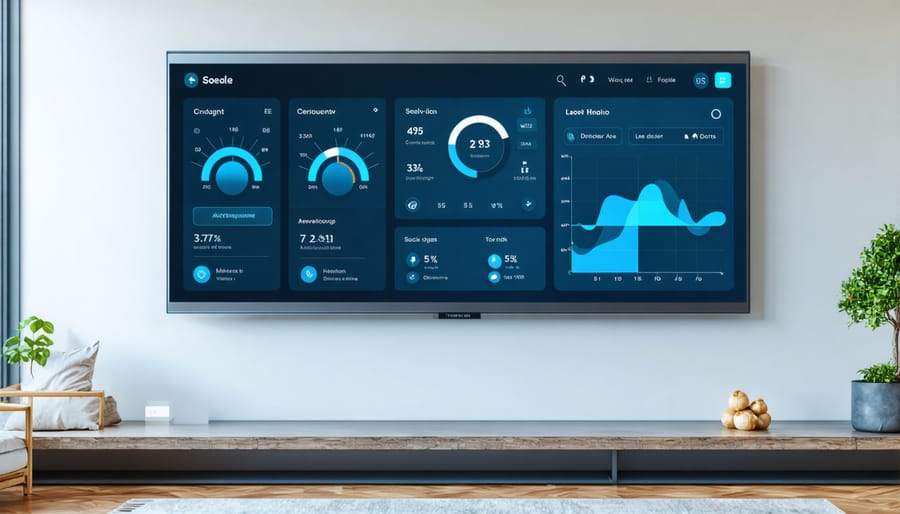Transform your renovation projects with cutting-edge building technology that’s revolutionizing how we reimagine spaces. 3D modeling software now enables homeowners to visualize complete makeovers before lifting a hammer, while smart sensors monitor structural integrity throughout the renovation process. Building Information Modeling (BIM) technology integrates seamlessly with eco-friendly renovation solutions, ensuring projects maximize energy efficiency while minimizing waste.
Advanced materials and automated construction tools have dramatically shortened project timelines and improved accuracy, making complex renovations more accessible to homeowners. From augmented reality apps that let you preview furniture placement to AI-powered project management systems that optimize workflow and material delivery, innovative building technology transforms traditional renovation challenges into opportunities for smarter, more sustainable home improvements.
These technological advances don’t just make renovations easier – they make them better. Precise measurements from laser scanning technology, real-time project tracking through mobile apps, and automated quality control systems ensure renovations meet exact specifications while staying on budget and schedule. The result? Smoother projects, superior outcomes, and spaces that truly reflect modern living standards.
3D Scanning and Digital Planning Technologies
Laser Scanning and Virtual Measurements
Remember when renovation planning meant endless hours of manual measurements and rough sketches? Those days are becoming history thanks to laser scanning technology. This game-changing innovation uses precise laser beams to create incredibly detailed 3D models of your space in minutes.
Think of it as taking thousands of measurements simultaneously with pinpoint accuracy. A laser scanner rotates 360 degrees, capturing every nook, cranny, and architectural detail of your space. The result? A perfect digital twin of your home that you can explore on a computer screen.
This digital model isn’t just pretty to look at – it’s incredibly practical. You can take virtual measurements anytime without revisiting the site, spot potential issues before construction begins, and visualize how new features will fit into your existing space. Want to know if that dream kitchen island will actually fit? The 3D model will tell you down to the millimeter.
The technology also helps prevent costly mistakes. Contractors can plan their work more accurately, order materials with greater precision, and identify potential challenges before breaking ground. This means fewer surprises, better budgeting, and smoother project execution.
For complex renovations, these scans can be shared with architects, designers, and contractors, ensuring everyone works from the same accurate information. It’s like having a complete digital blueprint of your home at your fingertips.

Virtual Reality Design Preview
Ever wondered what your renovation project will look like before swinging the first hammer? Virtual reality (VR) technology is making this possible, revolutionizing how we preview and plan home improvements. By putting on a VR headset, you can now take a virtual walk through your future space, getting a realistic feel for layout changes, color schemes, and design elements.
This immersive experience helps you make more confident decisions about your renovation plans. Instead of relying on static 2D drawings or trying to imagine how that open-concept kitchen will flow, VR lets you experience the space as if it were already built. You can check if the island is properly sized, ensure traffic patterns make sense, and even test different lighting configurations.
The technology is particularly helpful when choosing finishes and materials. Want to see how those dark cabinets look with your chosen countertop? Or wondering if that bold wallpaper might be too overwhelming? VR allows you to experiment with different combinations without spending a dime on samples or making costly mistakes.
For contractors and designers, VR serves as a powerful communication tool. They can guide you through proposed changes, pointing out specific features and addressing concerns in real-time. This visual alignment between your vision and their plans helps prevent misunderstandings and reduces the likelihood of expensive mid-project changes.
Remember, while VR previews are incredibly realistic, they’re best used as part of a comprehensive planning process that includes traditional methods and expert consultation.
Smart Materials and Installation Systems
Self-monitoring Building Materials
Imagine your walls could tell you when they’re stressed or your foundation could alert you before problems arise. That’s exactly what self-monitoring building materials do, bringing a whole new level of intelligence to home renovation projects.
These smart materials come equipped with tiny embedded sensors that continuously monitor various conditions. For example, smart concrete contains small sensors that detect stress, moisture levels, and temperature changes. This means you can spot potential cracks or structural issues before they become visible to the naked eye.
Similarly, self-monitoring insulation can track temperature variations and energy efficiency in real-time. Through a simple smartphone app, you can see exactly how well your walls are performing and identify any areas where heat might be escaping.
One of the most exciting developments is smart paint that changes color when detecting moisture or structural movement. This early warning system helps you address water damage or foundation issues before they escalate into costly repairs.
These materials don’t just monitor themselves – they communicate with each other and your home’s central system. Imagine receiving a notification that your bathroom wall is detecting unusual moisture levels, allowing you to investigate a potential leak before it causes serious damage.
While self-monitoring materials might cost more upfront, they can save significant money in the long run by preventing major repairs and extending the life of your renovation work. They’re particularly valuable in areas prone to weather damage or in older homes where structural issues are more common.
Remember, these materials work best as part of a comprehensive home monitoring system, providing you with peace of mind and proactive maintenance capabilities.

Energy-efficient Installation Solutions
Modern installation techniques have revolutionized the way we approach energy-efficient home improvements, making it easier than ever to create sustainable living spaces. Today’s innovative solutions focus on maximizing efficiency while minimizing disruption during the renovation process.
One of the most significant advances is the development of spray foam insulation technology, which allows for precise application and superior coverage compared to traditional batting. This method effectively seals even the smallest gaps and creates an airtight envelope around your home, dramatically reducing energy loss.
Smart window installation systems now incorporate thermal breaks and advanced glazing techniques that can be completed in a fraction of the time traditional methods required. These systems not only improve installation accuracy but also ensure better thermal performance and longevity of the windows.
HVAC installations have also seen remarkable improvements with the introduction of modular systems and pre-fabricated components. These elements can be quickly assembled on-site, reducing installation time while ensuring optimal performance. Modern ductwork solutions featuring antimicrobial coatings and seamless connections help maintain better air quality and reduce energy waste.
For lighting systems, wireless technologies have eliminated the need for extensive rewiring in many cases. LED fixtures with integrated sensors can be installed with minimal structural impact, while smart controls allow for automated energy management.
The latest water heating solutions incorporate quick-connect fittings and pre-insulated pipes, making installation more efficient and reducing heat loss. These systems can be precisely calibrated to maintain optimal performance, leading to significant energy savings over time.
Remember to work with certified installers who are familiar with these modern techniques to ensure you get the maximum benefit from these innovative solutions.
Project Management and Automation Tools
Cloud-based Project Tracking
Gone are the days of shuffling through paper plans and endless email chains. Today’s renovation projects benefit immensely from cloud-based project tracking systems, making it easier than ever to manage your cost-effective home updates with precision and clarity. These digital platforms serve as virtual command centers where everyone involved in your renovation can collaborate seamlessly.
Think of these systems as your renovation’s digital hub, where contractors can upload daily progress photos, homeowners can approve design changes in real-time, and project timelines automatically update as work progresses. Popular platforms like Buildertrend and CoConstruct allow you to track expenses, manage schedules, and communicate with your team all in one place.
What makes these tools particularly valuable is their accessibility – you can check on your project’s status from anywhere, at any time, using your smartphone or tablet. Need to approve a paint color while you’re at work? Simply log in and view the options. Wondering if the tiles you ordered have arrived? Check the delivery status with a quick tap.
These platforms also maintain a detailed record of all decisions and changes, which helps prevent miscommunication and keeps everyone accountable. Plus, having all your project documents stored securely in the cloud means you’ll never lose important information, and you can easily reference details even after the renovation is complete.
Automated Quality Control Systems
Modern renovation projects benefit tremendously from automated quality control systems that take the guesswork out of ensuring top-notch results. These smart systems use a combination of sensors, scanning technology, and data analysis to monitor every aspect of your renovation work in real-time.
One of the most impressive innovations is 3D laser scanning, which creates precise digital models of your space before, during, and after renovation. These scans can detect even minimal deviations from the planned design, helping catch potential issues before they become costly problems. For instance, if a wall isn’t perfectly straight or floor levels are slightly off, the system alerts you immediately.
Moisture detection systems are another game-changer, particularly for bathroom and kitchen renovations. These smart sensors continuously monitor humidity levels in walls and floors, helping prevent mold growth and ensuring proper drying times for materials. They can even send alerts to your phone when moisture levels exceed safe thresholds.
Quality control has also gone mobile with smartphone-based apps that use AI to analyze construction materials and finished work. Simply snap a photo, and the app can assess everything from paint coverage uniformity to proper tile spacing. This technology makes it easier for homeowners to verify work quality without needing extensive technical knowledge.
These automated systems not only improve accuracy but also save time and money by catching issues early and maintaining consistent quality throughout your renovation project.
Smart Home Integration During Renovation
Pre-wiring and Infrastructure Planning
Smart home technology isn’t just about adding gadgets after renovation – it starts with thoughtful pre-wiring and infrastructure planning. Future-proofing your renovation means considering how technology will evolve and ensuring your home can adapt seamlessly.
Start by mapping out potential locations for smart devices like security cameras, speakers, and lighting controls. Install extra electrical outlets and ethernet ports in strategic spots, including ceiling locations for wireless access points. Consider running conduit in walls to make future cable installations easier without causing damage.
Create a dedicated space for a network hub or smart home control center, ensuring proper ventilation and power supply. Plan for backup power systems to keep essential smart features running during outages. Don’t forget about wire management – include accessible pathways behind walls and in crawl spaces.
Think beyond current needs. Include USB outlets, wireless charging stations, and smart switch-ready wiring. Consider automated systems for HVAC, lighting, and security, installing the necessary infrastructure even if you’re not ready to implement these features immediately.
Remember to document all wiring locations and create a detailed infrastructure map for future reference.
Integrated Smart Systems
Modern renovation projects are increasingly incorporating smart home systems that transform ordinary spaces into intelligent, responsive environments. From voice-controlled lighting to automated climate control, these integrated solutions enhance both comfort and efficiency. Popular options include smart thermostats that learn your preferences while delivering significant smart home energy savings, and advanced security systems featuring doorbell cameras and smart locks.
Consider incorporating smart lighting systems that adjust based on natural light levels and occupancy, or whole-home audio solutions that create seamless entertainment zones. Smart blinds and curtains can automatically manage natural light, while connected appliances enable remote monitoring and control of your home systems.
The key is choosing systems that work together seamlessly. Look for devices that support major platforms like Apple HomeKit, Google Home, or Amazon Alexa to ensure compatibility. Many homeowners start with a smart hub as their foundation, then gradually add compatible devices as their needs evolve. Remember to plan for adequate WiFi coverage and consider professional installation for more complex systems to ensure optimal performance.

As we’ve explored throughout this article, innovative building technology has revolutionized the way we approach renovation projects, making them more efficient, cost-effective, and successful than ever before. From 3D visualization tools that help us make confident design decisions to smart sensors that monitor structural integrity, these technological advances have transformed what’s possible in home renovation.
The benefits are clear: reduced project timelines, better budget management, improved accuracy in planning and execution, and enhanced safety measures throughout the renovation process. Homeowners and contractors alike are finding that embracing these technologies leads to smoother projects with fewer surprises and better outcomes.
Looking ahead, the future of renovation technology is even more exciting. We’re seeing the emergence of artificial intelligence that can predict maintenance needs, augmented reality that allows for real-time visualization of design changes, and sustainable building materials that integrate with smart home systems. These innovations aren’t just making renovations easier – they’re making our homes smarter, more efficient, and more comfortable.
Whether you’re planning a minor update or a major overhaul, considering these technological solutions can make a significant difference in your renovation journey. As these tools become more accessible and user-friendly, they’re no longer just for professional contractors – they’re becoming essential resources for homeowners who want to make informed decisions about their renovation projects.
Remember, the key to successful renovation isn’t just about using technology for technology’s sake, but about choosing the right tools that align with your project goals and comfort level. The future of home renovation is here, and it’s more exciting and achievable than ever before.
